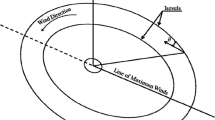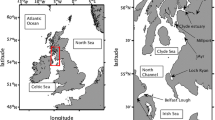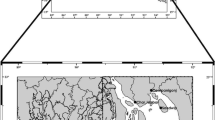Abstract
A two-dimensional vertically integrated hydrodynamic finite-element model of the west coast of Britain is used to examine the response of the region to extreme meteorological forcing. The extent to which tide–surge interaction modifies the computed surge elevation and current distributions is examined in detail. The nature of the finite-element model with its ability to refine the mesh in nearshore regions is ideal for examining the influence of non-linear effects upon surges in these regions. Calculations using spatially uniform orthogonal wind stresses show that the surge elevation and current in shallow water are particularly sensitive to the method used to remove the tide as a result of the highly non-linear nature of the tide–surge interaction in these regions. The most accurate means of de-tiding the solution is by subtracting a tide derived by harmonic analysis of the tide and surge time series at the time of the surge. Subtracting a tide-only solution (the usual approach) leads to tidal energy leaking into the surge solution. Calculations show that this arises because the surge modifies the tidal amplitude and phase in shallow-water regions to such an extent that they are appreciably different to those found in the tide-only calculation. Results suggest that this problem becomes more important, as nearshore meshes are refined in an attempt to improve surge prediction. This suggests that in the future, highly accurate fine-mesh models will be required to compute total water levels without the present linear separation into tidal and surge signal used in operational surge prediction.













Similar content being viewed by others
References
Bernier NB, Thompson KR (2006) Predicting the frequency of storm surges and extreme sea levels in the northwest Atlantic. J Geophys Res 111:C100009
Bobanovic J, Thompson KR, Desjardins S, Ritchie H (2005) Forecasting storm surges along the east coast of Canada and the northeastern U.S.: the storm of 21 January 2000. Atmos–Ocean 44(2):151–161
Davies AM, Hall P (2002) Numerical problems associated with coupling models in shelf edge regions. Appl Math Model 26:807–831
Davies AM, Jones JE (1992) A three-dimensional wind driven circulation model of the Celtic and Irish Seas. Cont Shelf Res 12:159–188
Davies AM, Kwong SCM (2000) Tidal energy fluxes and dissipation on the European continental shelf. J Geophys Res 105(C9):21969–21989
Davies AM, Lawrence J (1995) Modelling the effect of wave-current interaction on the three-dimensional wind driven circulation of the eastern Irish Sea. J Phys Oceanogr 25:29–45
Davies AM, Kwong SCM, Flather RA (2000) On determining the role of wind wave turbulence and grid resolution upon computed storm driven currents. Cont Shelf Res 20:1825–1888
Davies AM, Hall P, Howarth MJ, Knight P, Player R (2001a) A detailed comparison of measured and modeled wind driven currents in the North Channel of the Irish Sea. J Geophys Res 106:19,683–19,713
Davies AM, Kwong SCM, Lee JC (2001b) A detailed comparison of a range of three-dimensional models of the M2 tide in the Faeroe Shetland Channel and northern North Sea. J Phys Oceanogr 31(7):1747–1763
Fernandes EHL, Dyer KR, Moller OO, Niencheski LFH (2002) The Patos lagoon hydrodynamics during an El Nino event (1998). Cont Shelf Res 22:1699–1713
Fernandes EHL, Marino-Tapia I, Dyer KR, Moller OO (2004) The attenuation of tidal and subtidal oscillations in the Patos Lagoon estuary. Ocean Dyn 54:348–359
Flather RA (1984) A numerical model investigation of the storm surge of 31 January and 1 February 1953 in the North Sea. QJR Meteorol Soc 110:591–612
Flather RA, Hubbert KP (1989) Tide and surge models for shallow water—Morecambe Bay revisited. In: Davies AM (ed) Modeling marine systems, vol. 1. CRC, Boca Raton, FL, pp 135–166
Fortunato AB, Baptista AM, Luettich RA (1997) A three-dimensional model of tidal currents in the mouth of the Tagus estuary. Cont Shelf Res 17:1689–1714
Fortunato AB, Oliviera A, Baptista AM (1999) On the effect of tidal flats on the hydrodynamics of the Tagus estuary. Oceanol Acta 22:31–44
Hall P, Davies AM (2005) The influence of sampling frequency, non-linear interaction, and friction effects upon the accuracy of the harmonic analysis of tidal simulations. Appl Math Model 29:533–552
Heaps NS (1983) Storm surges, 1967–1982. Geophys J R Astron Soc 74:331–376
Heniche M, Secretin Y, Boudreau P, Leclerc M (2000) A two-dimensional finite element drying-wetting shallow water model for rivers and estuaries. Adv Water Resour 23:359–372
Horsburgh KJ, Wilson C (2007) Tide–surge interaction and its role in the distribution of surge residuals in the North Sea. J Geophys Res 112:C08003
Ip JTC, Lynch DR, Friedrichs CT (1998) Simulation of estuarine flooding and dewatering with application to Great Bay, New Hampshire. Estuar Coast Shelf Sci 47:119–141
Jones JE (2002) Coastal and shelf-sea modelling in the European context. Oceanogr Mar Biol 40:37–141
Jones JE, Davies AM (1996) A high-resolution, three-dimensional model of the M2, M4, M6, S2, N2, K1 and O1 tides in the eastern Irish sea. Estuar Coast Shelf Sci 42:311–346
Jones JE, Davies AM (1998) Storm surge computations for the Irish Sea using a three-dimensional numerical model including wave–current interaction. Cont Shelf Res 18:201–251
Jones JE, Davies AM (2001) Influence of wave–current interaction and high frequency forcing upon storm induced currents and elevations. Estuar Coast Shelf Sci 53:397–414
Jones JE, Davies AM (2003a) Processes influencing storm-induced currents in the Irish Sea. J Phys Oceanogr 33:88–104
Jones JE, Davies AM (2003b) On combining current observations and models to investigate the wind induced circulation of the eastern Irish Sea. Cont Shelf Res 23:415–434
Jones JE, Davies AM (2005) An intercomparison between finite difference and finite element (TELEMAC) approaches to modelling west coast of Britain tides. Ocean Dyn 55:178–198
Jones JE, Davies AM (2006) Application of a finite element model (TELEMAC) to computing the wind induced response of the Irish Sea. Cont Shelf Res 26(12–13):1519–1541
Jones JE, Davies AM (2007a) On the sensitivity of tidal residuals off the west coast of Britain to mesh resolution. Cont Shelf Res 27:64–81
Jones JE, Davies AM (2007b) On the sensitivity of higher tidal harmonics to nearshore topography and element size in a finite element model. Cont Shelf Res 27(14):1908–1927
Kwong SCM, Davies AM, Flather RA (1997) A three dimensional model of the principal tides on the European shelf. Prog Oceanogr 39(3):205–262
Lennon GW (1963) The identification of weather conditions associated with the generation of major storm surges along the west coast of the British Isles. QJR Meteorol Soc 89:381–394
Prandle D, Wolf J (1978) The interaction of surge and tide in the North Sea and River Thames. Geophys J R Astron Soc 55:203–216
Walters RA (2005) Coastal ocean models: two useful finite element methods. Cont Shelf Res 25:775–793
Werner FE (1995) A field test case for tidally forced flows: a review of the tidal flow forum. In: Lynch DR, Davies AM (eds) Quantitative skill assessment for coastal ocean models. American Geophysical Union, Washington, DC, pp 269–284
Wolf J, Flather RA (2005) Modelling waves and surges during the 1953 storm. Philos Trans R Soc A 363:1359–1375
Acknowledgements
The origin of the TELEMAC system is EDF-LNHE and is therefore © EDF-LNHE. Thanks are due to Andrew Lane for providing accurate Mersey bathymetry. The authors are indebted to R.A. Smith for help in preparing the diagrams and L. Parry for typing the paper.
Author information
Authors and Affiliations
Corresponding author
Additional information
Responsible editor: Phil Dyke
Rights and permissions
About this article
Cite this article
Jones, J.E., Davies, A.M. Influence of non-linear effects upon surge elevations along the west coast of Britain. Ocean Dynamics 57, 401–416 (2007). https://doi.org/10.1007/s10236-007-0119-0
Received:
Accepted:
Published:
Issue Date:
DOI: https://doi.org/10.1007/s10236-007-0119-0




